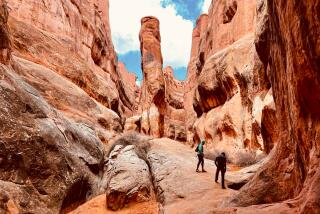The Ozark Experience
Arkansas is one of Americaâs most outdoorsy states, and it works hard to promote itself as a destination for canoeing, camping, fishing and hiking. âThe Natural State,â as it calls itself, has varied topography: hardwood forests, cypress-draped bayous, prairies, misty lakes, a thousand and one named and unnamed creeks.
But for all of Arkansasâ splendid diversity, itâs the Ozarks that may be the most fascinating destination to travelers. Visitors can listen to Ozark music and observe the fashioning of rag rugs, oak rockers or other Ozark crafts.
For the hiker, a great way to explore the Ozarks is on the 187-mile Ozark Highland Trail, often rated one of the top 10 trails in America by hiking experts. White Rock Mountain, Little Mulberry Creek, Haw Creek Falls, Ozone Camp, Salt Fork and Potato Knob are some of the intriguing places on the route. Most of the trail meanders through the 1-million-acre Ozark National Forest, created by President Theodore Roosevelt in 1908.
âThe Ozarks are largely undiscovered by tourists, and the Ozark Highland Trail is virtually unknown to hikers,â says Tim Ernst, president of the Ozark Highland Trail Assn. and author of a guidebook to the trail.
The trail has been a longtime labor of love for the Fayetteville-based nature photographer. During the 1970s, while employed by the National Forest Service, Ernst championed the cause of a trans-Ozarks trail. The Forest Service began cutting the trail, but when it faltered in 1981, Ernst founded the Ozark Highland Trail Assn. to oversee the trailâs completion. He has organized trail-building crews, lobbied in Washington, D.C., and rallied conservationists in his native state.
The Ozark Highlands Trail is very well-marked. Thanks to Ernst and his trail association, there is a milepost for every mile of trail. Innumerable 2-by-6-inch paint blazes mark the way: white for the main trail, blue for all side and spur trails.
Not every step of the way is pretty, Ernst points out. Ozark National Forest is very much a working forest--that is to say, hikers may hear the sounds of bulldozers cutting roads, chain saws cutting trees . . . and one more sound, too: gunfire. Ernst cautions hikers, particularly those from out of state, that Arkansas has a huge population of hunters--and one animal or another, it seems, is âin seasonâ from September to June.
For most of Americaâs long-distance trails--the Appalachian, Continental Divide, Pacific Crest, etc.--summer is the season to sojourn. Not so, however, on the Ozark Highlands Trail, when summer brings intense heat and humidity, dangerous lightning storms and more ticks, chiggers and blood-thirsty bugs than you can shake a walking stick at.
Winter months are good day-hiking months. The woods are in a state of what Arkansans call âleaf outâ; that is to say, they are barren of foliage, allowing good views. Daytime temperatures are in the 30s to 50s--good hiking weather if youâre warmly attired. Nights are long and cold, with temperatures in the teens or lower.
Springtime, when the azaleas and dogwood bloom, is a terrific time to be on the trail.
October is a grand month to gambol through the Ozarks. Daytime temperatures are in the 70s, with nighttime lows in the 40s and 50s. The fall color display (one of the stateâs best-kept secrets) rivals that of Colorado and New England.
A great place to begin your exploration of the Ozarks is at the beginning of the Ozark Highlands Trail in Lake Ft. Smith State Park. Tucked away in an Ozark Mountain valley, this park offers a splendid sampling of the Ozarks and a taste of the trail that just might whet your appetite for hiking the entire 187 miles to its present end at the Buffalo River, near the Missouri border.
Directions to trail head: From Interstate 40, six miles east of Ft. Smith, take the Lake Ft. Smith State Park exit (U.S. 71) and travel north 12 miles to the hamlet of Mountainburg. Watch for the signed turnoff to the state park at the northern edge of town and follow the park road to the visitor center. Signed Ozark Highlands Trail begins at the edge of the parking area.
The hike: The footpath ascends the side of the lakeâs dam to a road. Turn right, walk 100 feet, then join a trail on your left heading into the woods. The trail climbs gradually for a mile.
After Milepost 1, OHT joins an old Jeep road and descends a bit. Just short of Milepost 2, youâll cross a creek and spy a blue-blazed spur trail that will take you to a rocky area at the base of a handsome waterfall.
OHT passes another waterfall and a junction with another spur trail--this one leading to a trail camp for hikers. Just before Milepost 3, youâll arrive at a rail junction. OHT continues straight ahead, but you turn left and cross a creek over a pile of logs--in fact, a beaver dam. You have a fair chance of spotting one of the busy, buck-toothed fellows working the pools hereabouts.
Your trail turns south, traveling alongside a creek that widens gradually before your very eyes into Lake Ft. Smith.
Half a mile from trailâs end, youâll reach an intersection. A right-forking path loops through the woods and reconnects with the main trail. Stay left and continue to the parkâs marina and dam. Either walk the access road across the dam or the park road back to the visitor center and trail head.
*
WHERE: Ozark Highlands Trail, Lake Ft. Smith State Park, Mountainburg, Ark.
DISTANCE: 6-mile loop around Lake Ft. Smith.
TERRAIN: Wooded valley, lake.
HIGHLIGHTS: Waterfalls, spring and fall color.
DEGREE OF DIFFICULTY: Moderate.
FOR MORE INFORMATION: For maps and literature, contact the Ozark Highlands Trail Assn., Box 1074, Fayetteville, Ark. 72702, (501) 442-2799; Lake Ft. Smith State Park, Mountainburg, Ark. 72946, (501) 369-2469. For general travel information about Arkansas, call (800) 628-8725.
More to Read
Sign up for The Wild
Weâll help you find the best places to hike, bike and run, as well as the perfect silent spots for meditation and yoga.
You may occasionally receive promotional content from the Los Angeles Times.






